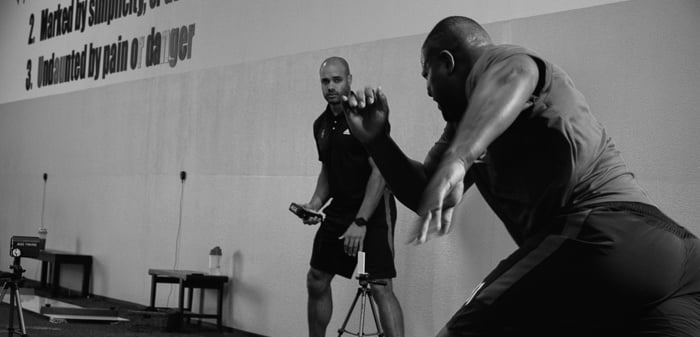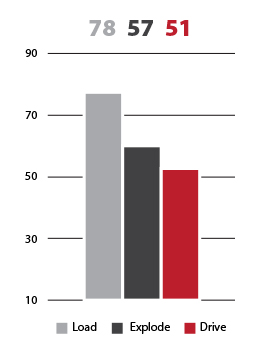
While developing our athlete evaluation and tracking software, one of the biggest benefits of having our coaching-focused performance center was practical application. Being able to count on large volumes of new data from elite athletes, delivered daily, has allowed us to continually refine our prescriptions derived from theSparta Signature. We often run into “stubborn” variables, where an athlete seems to lag at improving a particular part of their signature (versus the other two variables). These outliers allow us to identify weaknesses in our program, and adjust as needed for all athletes, or refine our prescriptions for specific populations.
For some of our athletes, LOAD was a stubborn variable. We still used squatting (front or back squat and single leg squat) as the statistics have been abundantly clear on improving LOAD better than any other stimulus. Rather, we eliminated much of the “quicker” movements for athletes who needed to improve LOAD, basically reducing their amount of plyometric or stretch shortening stimulus. We replaced these plyometrics with longer, heavier medicine ball throws and emphasized the preceding anterior strength stimulus (squat).

In addition to movement selection, technology should also dictate the cues from the coach and focus of the athlete during execution. In most lifts like a squat, the goal is to move more weight, so we made the goal of the squat throw to throw for more distance, much like a shot put. This movement goal is different than our other medicine ball throws which focus on speed. But by providing a heavier medicine ball (15 pounds) compared to other throws (4 pounds), we change the movement stimulus to require more strength and encourage one outcome, distance, rather than the confusion often presented with more distance and speed.
Having the database helped us come up with this idea. We noticed that big lineman, baseball catchers, or rugby front row (athletes usually characterized by high LOAD) excelled at squat and long, slow movements (see Movement Signature to the right). With these athletes, we go so far as to avoid squatting and long slow throws because of all the stimulus they get from their sport. This approach eliminates any coach or athlete bias toward certain exercises because of the data that we see over time. If plans are not working or progressing on force plate variables like the data predicts, we create a slight variation of plan rather than changing multiple exercises or relying on bias.
It seemed counter-intuitive at first, but poor use of stretch shortening (plyometric ability) in jumping athletes could be due to lack of ability to create tension initially (LOAD), making squatting or slower throws the best way to develop their ability to move quicker. Having a dynamic assessment (and database) that allowed us to identify the right approach and alter our subsequent coaching cues (slow/heavy), helped us make the necessary changes to our athletes’ program and further shorten their path to improving LOAD.